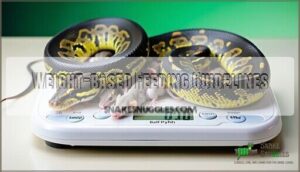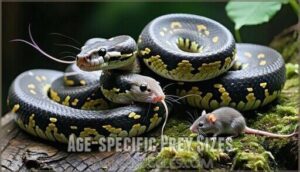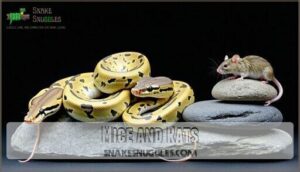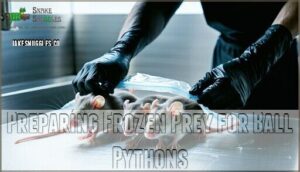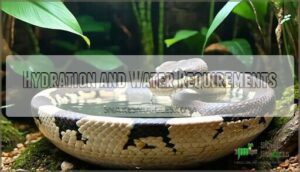This site is supported by our readers. We may earn a commission, at no cost to you, if you purchase through links.
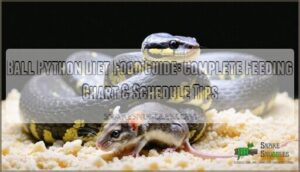 Your ball python diet food guide starts with understanding that these snakes are basically living garbage disposals with very specific preferences.
Your ball python diet food guide starts with understanding that these snakes are basically living garbage disposals with very specific preferences.
You’ll feed juveniles weekly and adults every 1-2 weeks using frozen-thawed rodents that weigh 10-15% of your snake’s body weight.
Start with mice for babies, then switch to rats as they grow since rats pack more nutritional punch, think of it like upgrading from snack-size to family-size portions.
Always thaw prey completely and warm it to body temperature before offering, consistency is your best friend here – establish a routine and stick to it.
The secret to avoiding picky eaters involves more than just prey selection, it requires understanding that establishing a routine and providing the right food in the right way is crucial, and that frozen-thawed rodents are a key part of this process.
Table Of Contents
- Key Takeaways
- Understanding Ball Python Dietary Needs
- Choosing The Right Prey Size
- Types of Prey for Ball Pythons
- Feeding Frequency for Ball Pythons
- Preparing Frozen Prey for Ball Pythons
- Live Vs. Frozen-Thawed Prey
- Supplementation in Ball Python Diets
- Preventing Obesity in Ball Pythons
- Addressing Common Feeding Issues
- Hydration and Water Requirements
- Frequently Asked Questions (FAQs)
- What is the best diet for a ball python?
- How often should I feed a ball python?
- Can you leave a heat lamp on 24/7 for ball python?
- What are pythons’ favorite foods?
- What will my ball python eat?
- What can I feed my ball python besides rodents?
- Can ball pythons eat fruit?
- What do ball pythons eat?
- How do you feed a ball python?
- Do ball pythons need feeding charts?
- Conclusion
Key Takeaways
- Feed the right size and frequency – You’ll need to feed juveniles weekly and adults every 1-2 weeks, using frozen-thawed rodents that weigh 10-15% of your snake’s body weight, matching the prey to your snake’s widest body diameter.
- Choose frozen-thawed over live prey – You’ll get safer, more convenient feeding with frozen-thawed mice and rats, since they eliminate injury risks and parasite transmission, while providing consistent nutrition.
- Establish a consistent routine – You’ll prevent picky eating by creating a regular feeding schedule, properly thawing and warming the prey to body temperature, and using feeding tongs for safe presentation.
- Monitor body condition to prevent obesity – You’ll need to watch for scale gaps, fat pads, and a rounded body shape, then adjust the feeding frequency and portion sizes if your snake shows signs of excess weight.
Understanding Ball Python Dietary Needs
Your ball python’s dietary needs mirror their wild counterparts perfectly.
Your snake’s wild instincts drive their captive feeding preferences—honor their natural carnivorous nature for optimal health.
These obligate carnivores require whole prey like mice and rats for complete nutrition.
Dietary diversity matters—wild ball pythons hunt various rodents and birds, so rotating between different prey types supports their natural behaviors.
Quality frozen prey meets all nutritional requirements while ensuring safety, making your feeding guide both practical and species-appropriate.
Choosing The Right Prey Size
You’ll need to select prey that measures 1 to 1.25 times your ball python’s widest body diameter to guarantee safe digestion and proper nutrition.
The correct prey size prevents regurgitation while providing adequate calories, and you can determine this by measuring your snake’s thickest point and choosing rodents that match or slightly exceed this width, ensuring proper nutrition.
Weight-based Feeding Guidelines
Getting the right prey size isn’t guesswork—it’s about matching your snake’s weight to their meal size.
Weight-based feeding guarantees your ball python gets proper nutrition without overfeeding. You’ll want to feed prey that’s 10-15% of your python’s body weight for healthy health and growth.
Here’s your feeding breakdown:
- Hatchlings (50-150g): Pinkie mice or small rat pups
- Juveniles (200-500g): Adult mice or medium rat pups
- Sub-adults (600-1000g): Small adult rats
- Adults (1200g+): Medium to large rats
Regular weight monitoring helps you adjust prey size as your snake grows, preventing obesity while supporting healthy development.
Age-specific Prey Sizes
Throughout your ball python’s life, their prey size needs change dramatically.
Hatchling prey starts with pinky mice weighing 2-5 grams – perfect for tiny mouths.
As your snake grows, juvenile portions progress to fuzzy mice, then hopper mice around 8-15 grams.
Juvenile python feeding requires careful attention to size progression since they’re growing rapidly.
Once your snake reaches adult size, adult meals typically consist of adult mice or small rats weighing 25-50 grams.
Adult python feeding focuses on maintaining weight rather than growth.
Senior diets may require adjustments if your older snake becomes less active.
The key to successful age-based feeding is matching prey to your snake’s current size, not their potential adult size.
Proper prey sizing prevents digestive issues and guarantees healthy nutrient absorption.
Ball python feeding should follow the 10-15% body weight rule throughout all life stages for peak health.
Types of Prey for Ball Pythons
You’ll need to select appropriate prey items that match your ball python’s natural carnivorous diet and nutritional requirements.
Your snake’s primary food sources should consist of properly sized mice and rats, though alternative options like chicks and quail can provide beneficial dietary variety when needed, including a natural variety.
Mice and Rats
Mice and rats form the backbone of your ball python’s diet, with each offering distinct advantages as your snake matures. Hatchlings start with pinky mice, progressing to adult mice as they grow, while juveniles move on to small rats, and adults thrive on jumbo mice or feeder rats.
Frozen-thawed rodents prove safer and more convenient than live prey, eliminating injury risks. You’ll want to match prey size to 10-15% of your snake’s body weight.
When sourcing rodents, prioritize reputable suppliers who maintain proper breeding feeders standards. Mouse varieties include pinkies, fuzzies, hoppers, and adults, while rat nutrition typically surpasses mice due to higher protein content.
- Frozen mice offer consistent sizing and reduce parasite transmission compared to wild-caught alternatives
- Rats provide better nutrition per feeding as your ball python reaches maturity, requiring fewer meals
Alternative Prey Options
Beyond standard mice and rats, diversifying your ball python’s menu with alternative prey items can mirror their wild hunting experiences. Quail and Chicks offer excellent protein variation, while Rabbit Alternatives like young rabbits provide larger meals for adult pythons.
When Sourcing Variety, consider reputable suppliers who maintain ethical breeding standards and consistent quality. Given that the majority of vertebrates consumed are farmed mice, it’s important to think about feeder rodent welfare when making dietary choices.
Here’s a Nutritional Comparison of common alternatives:
| Prey Type | Protein Content | Fat Content | Availability |
|---|---|---|---|
| Quail | High | Moderate | Limited |
| Chicks | Moderate | Low | Good |
| Rabbits | High | Low | Seasonal |
| Gerbils | Moderate | High | Variable |
Smart Acceptance Strategies include gradual introduction and proper food size matching. Some pythons readily accept new options, while others need patience. Remember, variety keeps feeding interesting while supporting ideal health through diverse nutritional profiles.
Feeding Frequency for Ball Pythons
Your ball python’s feeding schedule changes dramatically as it grows, with hatchlings requiring meals every 5-7 days while mature adults thrive on feeding intervals of 2-3 weeks.
Understanding these age-specific timing requirements guarantees your snake maintains healthy health without the risks of underfeeding or obesity that come from incorrect scheduling.
Hatchling Feeding Schedule
First meals for your ball python hatchling require careful attention and a consistent schedule. You’ll need to establish frequent feeding every 5-7 days during their first six months of life.
This ball python feeding routine differs substantially from adult schedules, as young snakes need regular nutrition for proper growth. Choose smaller prey items that match your hatchling’s size – typically pinkie mice or small fuzzies.
The prey size should equal your snake’s thickest body section. Frozen mice work perfectly and reduce injury risks compared to live feeding.
Monitoring weight becomes vital during this period. If your hatchling refuses food, don’t panic – they can survive a month without eating. Track their feeding frequency and adjust as needed.
Use feeding tongs to offer prey safely, and always provide fresh water. Watch for regurgitation signs, which indicate you’re feeding too large or too frequently.
Adult Feeding Schedule
Adult ball pythons require a completely different approach than their younger counterparts. Optimal frequency shifts to every 2-3 weeks, allowing proper digestion time between meals. Weight-based feeding becomes critical for obesity prevention – your snake’s prey should match its mid-body width.
Here’s your adult feeding schedule roadmap:
- Monitor body condition monthly to adjust feeding frequency
- Skip meals during shedding periods due to shedding impact on appetite
- Reduce prey size frequency during breeding schedules when males fast naturally
- Age-based feeding means larger meals less often
- Track weight changes to prevent overfeeding issues
Preparing Frozen Prey for Ball Pythons
Preparing frozen prey properly guarantees your ball python gets a safe, nutritious meal without unnecessary risks.
You’ll need to thaw and warm the prey correctly to mimic live conditions and encourage feeding.
Thawing Methods
Thawing prey for your ball python is straightforward but requires care to maintain safety and cleanliness. The best method is Refrigerator Thawing, where frozen rodents are moved to the fridge overnight for even defrosting.
If you’re short on time, a Water Bath works too—seal the prey in a bag and submerge it in cold water, changing the water every 30 minutes. Avoid microwaves, as they create hot spots that could harm your snake.
Here’s a quick comparison of thawing methods:
| Method | Time Required | Pros |
|---|---|---|
| Refrigerator Thawing | 8-12 hours | Even thawing, low bacteria risk |
| Water Bath | 1-2 hours | Faster, simple |
| Microwave Concerns | Not recommended | Risk of uneven heating |
Always handle prey with clean tongs, and discard uneaten portions promptly. Proper handling during frozen rodents thawing is vital for your snake’s health.
Warming Techniques
How do you verify your ball python’s meal is just the right temperature?
Warming prey properly after defrosting is vital for safe feeding.
Here are some effective warming methods to try:
- Warm water immersion: Place thawed prey in a sealed plastic bag and submerge it in warm water (100-110°F) for 10-15 minutes.
- Heat pad warming: Use a reptile heat pad, turning the prey occasionally to avoid uneven heating.
- Room temperature warming: Let prey sit at room temperature for 30-60 minutes, though this may not reach ideal warmth.
- Head warming: Focus on slightly warming the prey’s head to mimic live prey and encourage feeding.
Always monitor temperatures carefully to avoid burns or overheating.
Using sterile frozen rodents reduces parasite risks.
Live Vs. Frozen-Thawed Prey
Choosing between live and frozen-thawed prey for your ball python impacts both safety and convenience.
Understanding the benefits and risks of each option helps you make the best decision for your snake’s health and well-being.
Safety Considerations
Feeding safety is key when caring for your ball python, especially when choosing between live prey and frozen rodents.
Live feeding carries risks like bites or parasites, while frozen-thawed prey is safer and easier to handle. Always use feeding tongs to avoid accidental strikes and maintain a clean, stress-free environment.
Wash your hands before and after handling prey or your snake, and never leave live prey unattended—it can harm your python. Sudden movements during feeding might startle them, so stay calm and steady.
Here’s a quick comparison:
| Aspect | Live Prey | Frozen-Thawed |
|---|---|---|
| Prey Handling | Difficult | Simple |
| Live Prey Risks | High | None |
| Hygiene | Parasite Risk | Cleaner Option |
| Feeding Safety | Less Controlled | More Controlled |
Nutritional Differences
Frozen-thawed prey isn’t just convenient—it’s a smart choice for maintaining prime nutrition.
Unlike live prey, it reduces parasite risks while offering consistent prey composition. Plus, stocking frozen options like mice, rats, or chicks makes managing nutrient variation easier, especially when addressing wild vs captive dietary needs.
As ball pythons are carnivorous, rodents are essential for their well-being.
Here’s a quick comparison:
| Prey Type | Nutritional Value | Safety |
|---|---|---|
| Frozen-Thawed | Balanced, reliable | Parasite-free |
| Live Prey | Variable | Injury risk |
| Wild-Caught | Unpredictable | Parasite-prone |
Supplement needs can also be minimized with a varied frozen diet. It’s practical, safe, and guarantees your ball python thrives.
Supplementation in Ball Python Diets
You don’t need to worry too much about supplementation for your ball python if you’re feeding them whole prey, as it already provides essential nutrients.
However, occasional calcium or multivitamin powders may help support their health, especially during growth or breeding, which can be a critical time for their overall health.
Calcium Supplementation
Although ball pythons typically meet calcium needs through whole prey, occasional supplementation guarantees robust health.
Calcium, paired with vitamin D3, supports strong bones and proper metabolism.
To safely supplement, dust prey sparingly with high-quality reptile calcium powder.
For ball python calcium needs, various products are available.
Over-supplementation risks are real, so moderation is key.
Here’s a quick guide to calcium supplementation:
- Calcium Sources: Use commercial powders or natural options like crushed eggshells.
- Supplement Dosage: Dust prey lightly every 2-3 feedings.
- D3 Importance: Choose supplements with vitamin D3 for better absorption.
- Over-Supplementation Risks: Watch for lethargy or appetite loss.
- Natural Alternatives: A varied prey diet reduces supplementation needs.
Consult a reptile vet for personalized advice.
Multivitamin Use
Multivitamins play a key role in preventing nutritional deficiencies in your ball python’s diet. They provide essential vitamins like A and D3, supporting overall health.
Use reptile-specific powders sparingly—about once every 4-6 feedings. Lightly dust prey items for balanced nutrition without overdoing it.
Ensuring proper nutrition may require quality python multivitamins.
- Pick trusted reptile-formulated multivitamins.
- Rotate with calcium supplements for variety.
- Increase usage for gravid females or growing juveniles.
- Avoid over-supplementing to prevent long-term effects like toxicity.
Proper supplementation keeps your python thriving!
Preventing Obesity in Ball Pythons
Preventing obesity in your ball python is essential for its long-term health and well-being.
By recognizing early signs of excess weight and adjusting feeding habits appropriately, you can guarantee your snake stays active and healthy.
Recognizing Obesity Signs
Spotting snake obesity starts with body condition. A healthy ball python has a gentle triangular shape, not a round or sausage-like appearance.
Look for scale gaps—when scales stretch apart due to excess fat—and check for fat pads or visible rolls along its body. Lack of muscle tone and lethargy signs can also indicate trouble.
| Indicator | What to Look For | Why It Matters |
|---|---|---|
| Body Shape | Rounded or tube-like | Suggests excess weight |
| Scale Gaps | Stretched scales | Signals fat accumulation |
| Fat Pads | Visible rolls or bulges | Points to snake obesity |
Adjusting Feeding Habits
If your ball python shows signs of obesity, tweak its feeding schedule to restore balance.
Start by reducing feeding frequency and portion sizes—especially during non-active periods like Seasonal Changes.
Stick to a feeding schedule that aligns with their age and size, avoiding overfeeding during Growth Spurts.
For Breeding Adjustments, increase meals temporarily but return to normal afterward.
Use feeding tongs to offer pre-killed prey, removing uneaten food promptly.
Encourage activity with climbing spots and enrichment.
A healthy ball python should have a slight triangular body shape.
These feeding tips can help prevent long-term health problems, ensuring a healthy ball python.
Addressing Common Feeding Issues
Feeding issues like refusal to eat or regurgitation can be frustrating, but they’re often manageable with the right approach.
Understanding your ball python’s behavior and environment is key to resolving these common problems effectively.
Refusal to Eat
Feeding refusal can be frustrating, but it’s often solvable with patience and adjustments.
Patience and small adjustments often turn feeding challenges into success stories for your ball python.
Reluctant eaters may react to environmental stressors or dietary boredom.
Try these feeding solutions:
- Check habitat conditions—ensure proper temperatures, humidity, and hiding spots to reduce stress.
- Experiment with prey presentation—wiggle food or leave it overnight for shy eaters.
- Switch prey size or type—smaller prey or variety can entice feeding.
- Minimize handling—improper handling or frequent disturbances can worsen snake feeding challenges.
Regurgitation
If your snake refuses food, it might signal stress or health issues, but regurgitation requires immediate attention.
Common regurgitation causes include stress, improper prey size, or temperature issues. Avoid handling your ball python for 48-72 hours post-feeding to prevent snake feeding regurgitation.
If regurgitation happens, wait two weeks before feeding again, using smaller prey. Monitor your snake for lethargy or appetite loss, as repeated incidents may need vet intervention.
Aid regurgitation prevention by maintaining proper husbandry. A key factor in prevention is understanding temperature and humidity effects on digestion.
Here’s a quick guide:
Hydration and Water Requirements
Good hydration is just as important as feeding when caring for your ball python.
Always provide a water bowl that’s shallow, easy to access, and large enough for your snake to soak in fully. Change the water every 2-3 days, or immediately if it’s soiled, using dechlorinated water at room temperature.
Avoid distilled or softened water, as these can harm your snake’s health.
Proper hydration supports healthy shedding and helps maintain ideal humidity levels in the enclosure.
If you notice signs of dehydration, like wrinkled skin or stuck shed, increase misting frequency slightly. Clean, fresh water is a simple way to keep your ball python hydrated and thriving—don’t skimp on this basic need!
Frequently Asked Questions (FAQs)
What is the best diet for a ball python?
Like a key releasing ideal health, you’ll want to feed your ball python frozen-thawed mice or rats weekly. Choose prey that’s 1-25 times your snake’s mid-body width for perfect nutrition.
How often should I feed a ball python?
Your ball python’s age determines feeding frequency. Hatchlings need meals every 5-7 days, juveniles eat weekly, and adults require feeding every 2-3 weeks. Overfeeding causes obesity, so adjust portions accordingly.
Can you leave a heat lamp on 24/7 for ball python?
Looking to keep your ball python cozy around the clock?
You can safely leave a heat lamp on 24/7, but you’ll need a thermostat to regulate temperatures and prevent overheating your snake.
What are pythons’ favorite foods?
Your ball python’s top picks are mice and rats – they’re nutritional powerhouses that’ll keep your snake thriving.
Rats pack more protein, while mice work great for younger pythons.
Both beat exotic alternatives hands-down, with mice being a great option.
What will my ball python eat?
Most ball pythons eat prey that’s 10-15% of their body weight.
Your snake will primarily consume mice and rats – frozen-thawed is safest.
Adult pythons typically eat medium rats, while juveniles prefer adult mice or rat pups.
What can I feed my ball python besides rodents?
You can occasionally offer chicks, quail, or young rabbits for variety, but mice and rats should remain your snake’s primary diet. Avoid amphibians, fish, insects, eggs, and other reptiles completely.
Can ball pythons eat fruit?
Studies show 100% of ball pythons are strict carnivores with digestive systems designed exclusively for meat.
No, you can’t feed your ball python fruit—their bodies completely lack the enzymes needed to process plant matter safely, which makes them strict meat eaters.
What do ball pythons eat?
You’ll need to feed your ball python whole prey items like mice and rats.
These carnivorous snakes require complete rodents for proper nutrition, with prey size matching their mid-body diameter perfectly.
How do you feed a ball python?
Like telegraph operators of old, you’ll thaw frozen rodents completely, warm them to 110°F.
Then use feeding tongs to present prey equal to your snake’s widest point, avoiding handling for 48 hours afterward.
Do ball pythons need feeding charts?
Yes, you’ll benefit from using feeding charts as helpful guidelines.
They provide age-based schedules and prey sizes, but remember to adjust based on your snake’s individual growth rate, body condition, and feeding response, which is a key factor to ensure the snake’s individual growth rate is considered.
Conclusion
What’s the key to successful ball python ownership?
Following this ball python diet food guide consistently guarantees your snake thrives for decades.
You’ve learned proper prey sizing, feeding schedules, and preparation techniques that prevent common issues like obesity and feeding strikes.
Remember that frozen-thawed rodents offer safety advantages over live prey, while maintaining proper hydration supports digestion.
Stick to your established routine, monitor your snake’s body condition regularly, and adjust portions as needed for peak health.
- https://www.zenhabitats.com/blogs/reptile-care-sheets-resources/ball-python-complete-food-guide?srsltid=AfmBOorqgxxh-qdS0moCVqXiH7n9aDeIoECgwl9kL47nbrugJKAbpZI0
- https://www.nwreptiles.com/general-ball-python-care-and-husbandry/
- https://a-z-animals.com/blog/ball-python-feeding-chart/
- http://kpexotics.com/Main/ball-pythons-care-feeding-guide/
- https://www.hvreptilerescue.org/resources/care-guides/ball-python-care-guide

